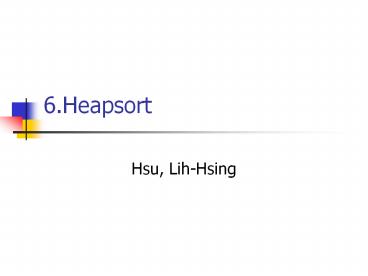6.Heapsort - PowerPoint PPT Presentation
Title:
6.Heapsort
Description:
There is a wide variety of sorting algorithms, and they use rich set of techniques. ... 2 then error 'new key is smaller than current key' 3 A[i] key ... – PowerPoint PPT presentation
Number of Views:99
Avg rating:3.0/5.0
Title: 6.Heapsort
1
6.Heapsort
- Hsu, Lih-Hsing
2
Why sorting
- 1. Sometimes the need to sort information is
inherent in a application. - 2. Algorithms often use sorting as a key
subroutine. - 3. There is a wide variety of sorting
algorithms, and they use rich set of techniques. - 4. Sorting problem has a nontrivial lower bound
- 5. Many engineering issues come to fore when
implementing sorting algorithms.
3
Sorting algorithm
- Insertion sort
- In place only a constant number of elements of
the input array are even sorted outside the
array. - Merge sort
- not in place.
- Heap sort (Chapter 6)
- Sorts n numbers in place in O(n lgn)
4
Sorting algorithm
- Quick sort (chapter 7)
- worst time complexity O(n2)
- Average time complexity O(n logn)
- Decision tree model (chapter 8)
- Lower bound O (n logn)
- Counting sort
- Radix sort
- Order statistics
5
6.1 Heaps (Binary heap)
- The binary heap data structure is an array object
that can be viewed as a complete tree.
Parent(i) return LEFT(i) return
2i Right(i) return 2i1
6
Heap property
- Max-heap A parent(i) ? Ai
- Min-heap A parent(i) Ai
- The height of a node in a tree the number of
edges on the longest simple downward path from
the node to a leaf. - The height of a tree the height of the root
- The height of a heap O(log n).
7
Basic procedures on heap
- Max-Heapify procedure
- Build-Max-Heap procedure
- Heapsort procedure
- Max-Heap-Insert procedure
- Heap-Extract-Max procedure
- Heap-Increase-Key procedure
- Heap-Maximum procedure
8
6.2 Maintaining the heap property
- Heapify is an important subroutine for
manipulating heaps. Its inputs are an array A
and an index i in the array. When Heapify is
called, it is assume that the binary trees rooted
at LEFT(i) and RIGHT(i) are heaps, but that Ai
may be smaller than its children, thus violating
the heap property.
9
- Max-Heapify (A, i)
- 1 l ? Left (i)
- 2 r ? Right(i)
- 3 if l heap-sizeA and Al gt Ai
- 4 then largest ?? l
- 5 else largest ? i
- 6 if r heap-sizeA and Ar gt Alargest
- 7 then largest ? r
- 8 if largest ? i
- 9 then exchange Ai ? Alargest
- 10 Max-Heapify (A, largest)
- Alternatively O(h)(h height)
10
Max-Heapify(A,2)heap-sizeA 10
11
6.3 Building a heap
- Build-Max-Heap(A)
- 1 heap-sizeA ? lengthA
- 2 for i ? ?lengthA/2? downto 1
- 3 do Max-Heapify(A, i)
12
(No Transcript)
13
(No Transcript)
14
(No Transcript)
15
(No Transcript)
16
6.4 The Heapsort algorithm
- Heapsort(A)
- 1 Build-Max-Heap(A)
- 2 for i ? lengthA down to 2
- 3 do exchange A1?Ai
- 4 heap-sizeA ? heap-sizeA -1
- 5 Max-Heapify(A.1)
17
The operation of Heapsort
18
Analysis O(n logn)
19
7.5 Priority queues
- A priority queue is a data structure that
maintain a set S of elements, each with an
associated value call a key. A max-priority queue
support the following operations - Insert (S, x) O(log n)
- Maximum (S) O(1)
- Extract-Max (S) O(log n)
- Increase-Key (S, x, k) O(log n)
20
Heap_Extract-Max(A)
- 1 if heap-sizeA lt 1
- 2 then error heap underflow
- 3 max ? A1
- 4 A1 ?Aheap-sizeA
- 5 heap-sizeA ? heap-sizeA - 1
- 6 Max-Heapify (A, 1)
- 7 return max
21
Heap-Increase-Key (A, i, key)
- 1 if key lt Ai
- 2 then error new key is smaller than current
key - 3 Ai ? key
- 4 while i gt 1 and AParent(i) lt Ai
- 5 do exchange Ai ? AParent(i)
- 6 i ? Parent(i)
22
Heap-Increase-Key
23
Heap_Insert(A, key)
- 1 heap-sizeA ? heap-sizeA 1
- 2 Aheap-sizeA ? -8
- 3 Heap-Increase-Key (A, heap-sizeA, key)































